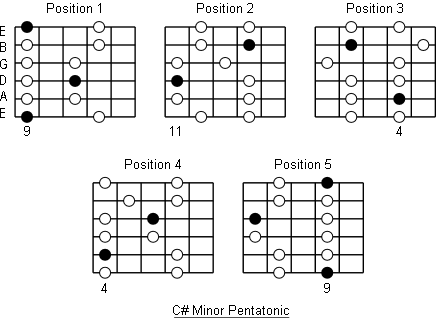What does it mean to know a scale in all 5 positions?
I just received this question in my inbox:
I play a lot more rhythm stuff than I do lead, so I’ve spent a lot more time on chord construction and order than I have with any scales, but I feel like I’m slowly pulling back the curtain to understand the relationship between the two. For example, I know the standard blues scale in A – what would be an example of four other (or five, if I’m not understanding the term) positions to play that in?
Ok, Knowing all the positions means, knowing the scale as it repeats across the fretboard. These are the 5 positions of C# minor pentatonic, below is an example:

When someone asks -can you play the blues scale in the 5 positions? They are asking if you know the individual notes in the 5 boxes for the scale.
For instance: Box “1” in the A Scale would start on the 5th fret or 17th fret.
Let’s take the 5th fret position. The A pentatonic starts from BOX 1 on the 5th fret move to BOX 2, then 3, and so on. Or if you go toward the nut, you go from Box 1 to Box 5. You can go up the fret board or down the fretboard and play the A pentatonic in any of those positions and it will fit musically. The Boxes are always in order. So no matter what key you play in, there is an order to the fretboard. Box 1 is always the same no matter what key you are in, same with Box 2, and so on. Here are the five positions for Minor Pentatonic. Find a song – Backing in A and play this scale from one of the two A positions on your rig.
You can play the A blues scale anywhere on the whole neck. If you highlight those notes on the fretboard you get a big pattern.
The problem being that is alot of information and not very manageable. So it can be broken down into positions or to put it another way, bite size chunks that help you remember / finger the whole thing in an easy manner.
For example, see this diagram. This is all the positions on the pentatonic scale (basically the blues scale). You can see the whole picture on the left and how it is broken down into 5 overlapping positions.
When you learn and improve with the positions you build that bigger picture map over time and you become less dependent on the positions, but they are a great way to learn scales. Exercises to connect / transfer between positions help as well to break the cages down.
Positions of the major scale is an interesting subject. The major scale has more notes and can be broken down a number of ways.

 Welcome to our website! Read trusted reviews before singing up for a paid membership program.
We are a 3rd party review site with over 26 years teaching experience, we do not own any of the products mentioned, but we may receive a commission if you signup for program through our affiliate links. Find Angelie Wright here on
Welcome to our website! Read trusted reviews before singing up for a paid membership program.
We are a 3rd party review site with over 26 years teaching experience, we do not own any of the products mentioned, but we may receive a commission if you signup for program through our affiliate links. Find Angelie Wright here on 


There are no comments yet, add one below.